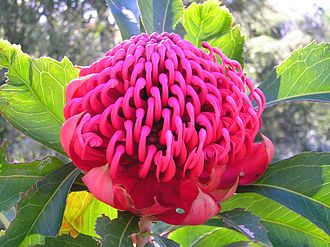Waratah

Waratah (Telopea) is an Australian-endemic genus of five species of large shrubs or small trees, native to the southeastern parts of Australia (New South Wales, Victoria and Tasmania). The most well-known species in this genus is Telopea speciosissima, which has bright red flowers and is the NSW state emblem. The Waratah is a member of the plant family Proteaceae, a family of flowering plants distributed in the Southern Hemisphere. The key diagnostic feature of Proteaceae is the inflorescence, which is often very large, brightly coloured and showy, consisting of many small flowers densely packed into a compact head or spike. Species of waratah boast such inflorescences ranging from 6–15 cm in diameter with a basal ring of coloured bracts. The leaves are spirally arranged, 10–20 cm long and 2–3 cm broad with entire or serrated margins. The name waratah comes from the Eora Aboriginal people, the original inhabitants of the Sydney area.
The genus Telopea belongs to the plant family Proteaceae. Within the Proteaceae, their closest relatives appear to be the genera Alloxylon (Tree Waratahs), Oreocallis and Embothrium, a group of generally terminal red-flowering plants that skirt the southern edges of the Pacific Rim. Together they make up the subtribe Embothriinae.[1][2] The genus was first described by Robert Brown in 1810 from the type species Telopea speciosissima. There are five species of plant within the genus, all of which readily hybridize in cultivation.[3] There are two main branches, with one being the species pair of T. speciosissima and T. aspera, with the other lineage giving rise to T. truncata first, then T. oreades and T. mongaensis.[4] The speciosissima-aspera lineage (clade) has two synapomorphies—distinguishing common characteristics presumed not present in ancestors—leaves with toothed margins, and large red involucral bracts. The truncata-oreades-mongaensis lineage has flowers that open from the centre to the edge of the inflorescence (basitonic) rather than the reverse (acrotonic), which is a feature of the speciosissima-aspera clade and more distant relatives.[3]
The propagation of waratah for commercial production is relatively easy in comparison to other stages of the growth cycle. Plants are usually propagated from cuttings, fresh seed or stored seed. Fresh seed has a good germination rate but deteriorates fairly rapidly unless stored at low temperature and low humidity. Dry seed will last a few years in refrigerated storage but should be treated with a general purpose fungicide prior to storage and at propagation to ensure good germination rates and healthy seedlings. The best time to take cuttings is when the plant is experiencing a flush of growth. The cuttings are taken from firm wood from the last twelve months growth. If plant material is scarce, single nodes can be used for cutting propagation.
Other methods of propagation that are successful but not widely used for commercial production include grafting and tissue culture. Stock for grafting is vigorous and as such is labour-intensive in constant control of stock regrowth from the lignotuber. As such, it is not a recommended method but is useful for the fast growth of limited material. Rootstock and scion combinations are used for many woody perennials to provide the necessary mix of floral or fruit characteristics and cultural requirements.
Tissue culture is very labour-intensive and would likely only be used in the case of rapidly increasing the number of plants from limited or valuable material. The process is complex though as different clones require different optimal culture conditions requiring different developmental work for each clone. There also exists problems with hardening off, with roots and leaves produced in vivo dying off on planting out.
For Telopea plants propagated from seed, the transition from seedling to flower takes about 5 years. Cuttings may take only 2 years. The most common form of propagation is from seed, however, certain varieties and cultivars must be propagated from cuttings if the grower wishes the plants to remain true to form. Fresh seed has a higher viability than cuttings and will germinate 2–3 weeks after sewing.
